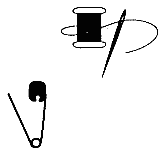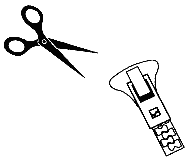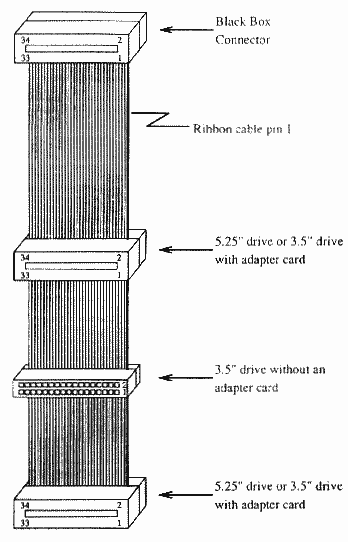 The Fitting
Room
The Fitting
Room
FASTER Floppy, FASTER!
Mike
Jewison, AC Staff Columnist
Always In A Hurry
I'll let you in on a little secret: I'm not a particularly patient person. I tend to be the sort of guy who stands in front of the microwave saying "Hurry up. Hurry up!", forgetting, of course, that what now takes a minute in the microwave might have taken five to ten minutes with a conventional oven. That's the problem as technology gets better (and faster); you can't remember what things were like before but at the same time you wonder how you ever did without it.
It's the same story with computers. I have a 25MHz 386-PC clone with a 9ms 80MB hard drive in addition to my family of three 8-bit Atari computers. One of the worst things I can do is use the 386 for a while and then hop over to my 800XL. As I slide in that floppy and power up the computer I find myself saying "Hurry up. Hurry up!" The only difference between this and the microwave story is that the slowness of the Atari floppy drives isn't imagined-it's legendary.
There are some SIO floppy drives for the Atari that offer improved access speed over the older drives. The XF551 has a high speed mode capable of increasing access speeds by a factor of three. ICD, before they dumped the 8bits, offered the US Doubler upgrade for the 1050. This was basically a set of two plug-in chips that not only gave the 1050 true double density but also UltraSpeed which, like the newer XF551, increased disk access by about a factor of three.
I, however, own neither of these floppy drives. I'm still using my old standby- a Percom RFD44S1- doublesided/double density and slow. To the best of my knowledge there were never any upgrades available to enable the Percom drives to run in UltraSpeed mode. If I want to obtain a faster floppy drive I'd have to look for a Doubled 1050 or an XF551 on the used market somewhere. The 1050, however, isn't double-sided and the problem with the XF551 is that it isn't compatible with the Percom. Each drive has a slightly different interpretation of "doublesided" which means that although any single-sided disk could be read with no problem by either drive, side 2 of any double-sided disk written by the Percom would be unreadable by the XF551 and vice-versa. The thought of having multiple copies of my disks in different formats didn't thrill me, so I decided to go another route.
Floppy Board
Last time you visited, I'd just installed a Black Box on my 800XL. The Black Box (hereafter referred to as the BB) is an interface from Computer Software Services which plugs into the PBI/ECI port on the 800XL/130XE computers and offers oodles of features, including: a SCSI port to enable you to connect any SCSI hard drive to your Atari, a Centronics parallel (printer) port and an RS-232 serial port. CSS also offers an add-on to the BB called the Floppy Board (FB) which, strangely enough, allows you to connect up to four industry standard floppy drives. Since the drives themselves are connected to the BB, this gives you floppy access at PBI/ECI speeds. As I happened to have a spare one of these "industry-standard" 360K 5.25-inch floppy drives sitting in my junk pile, it seemed the purchase of the FB was the way for me to go.
I placed my order with CSS and received the package in about ten days. The FB has a slightly smaller footprint than the BB and is designed to mount on top of the BB upside-down: the two circuit boards are the slices of bread in a typical BB/FB "sandwich", with chips for "meat". There's also a replacement EPROM for the BB that comes with the FB; you just pry out the EPROM on the BB and replace it with the new one. There are a couple of solder connections to be made between two pins on the replacement EPROM and points on the BB board. Fortunately, the day the FB arrived I didn't have the time to install it. I say fortunately because the next day I received from CSS a small padded envelope with upgrade ROMs for both the BB and the FB. After another day or two I found time to install the new ROMs on the boards, make the necessary solder connections, and plug the FB onto the BB. The installation instructions are very clear, and I had absolutely no problems in getting everything up and running.
Cable Tied
I had heard from other owners of the BB/FB combo, most notably our Managing Editor- The 8-Bit Alchemist Himself- that building the ribbon cables to connect the floppy drives to the BB was difficult because the instructions in that area were unclear. I decided to stay away from that problem by ordering a pre-fabricated cable from CSS. I simply plugged one end of the cable into my 360K drive and the other into the floppy port on the BB.
The cable I received from CSS was simple enough. I made a cursory comparison of the cable with the diagram included in the FB manual and could see no difference. I then asked Ben for a copy of the notes he created while trying to make his own cables. It was after reading Ben's notes, comparing those with the FB instructions, and then comparing that with my cable that I realized The Dear Old Alchemist was right: there was indeed an error in the FB cabling directions!
The pin configurations shown in the FB instructions for the 34-pin card-edge connectors are reversed left-to-right in two dimensions, which can lead to all sorts of brain damage resulting from the mental gymnastics involved in trying to understand the diagram. [Alchemists comment. for some months following the experience with the FB ribbon cable I walked in circles babbling to myself and muttering incoherent epithets against the Puff Person. My cure commenced when Bob Woolley mercifully gave me a stock 1200XL with hideously awful video performance. While trying to sort out the 1200XL's video problems my brain received massive doses of hi voltage ionizing radiation. Im pleased to report I'm now back to my usual manic self. -BP] I've drawn up a corrected version of the diagram based on the cable CSS prepared for me (Figure 1). If you decide to make your own cables for your FB I think you'll find this diagram much easier on the neurons than the one accompanying the FB instructions. Hopefully this is something CSS will correct in a future version of the docs.
(I was also informed by The Alchemist that the FB instructions pertaining to different brands of compatible hi-density 3.5" drives used with the FB are exactly backwards. Teac drives do work fine, but avoid Sony at all costs! Ben has been using 1.44M Teac drives for over a year.)
Check-Out Time
Now that I had the cabling complete, I left my Percom disconnected from the system (since I just wanted to play with the FB drive), stuck a MyDOS disk into the FB drive and powered up the computer. The disk booted up as it should, and roughly 15 seconds later up came the MyDOS menu screen. After congratulating myself, I decided to format a MyDOS disk in UltraSpeed format. After all, fast floppy access was what drove me to purchase the FB in the first place.
In order to put any FB drives into UltraSpeed mode you need to enter the BB's Configuration Menu by pressing a button on the BB. BB Menu selection "A" (Drive Configuration) will allow you to set the drive to US format. While you're in the drive configuration area, pressing the "F" key (Floppy Board Parameters) gives you access to setup parameters for the FB. You can set the size of your floppies (single or double sided; 3.5", 5.25", or even 8") as well as the mode for double-sided disks. The FB allows you to select among XF, Percom, or ATR-8000 modes for doublesided floppies. For me, this ensures I'll be able to read my Percom disks with the FB as well as any DS disks which might have been written by an XF551. In other words, complete compatibility with virtually all double-sided Atari drives!
Once I had configured my floppy appropriately I escaped back to the main BB menu. When you're formatting a disk with the FB, you have two options as long as you aren't using a high-density (HD) drive. You can format the disk with your favorite DOS as you normally would, or you can use the floppy formatter built-in to the FB to create a MyDOS or SpartaDOS disk. HD floppies require the use of the FB formatter, as neither DOS is capable of formatting a HD diskette. As an experiment, I decided to time both methods. It took 44 seconds to format a DS/DD disk in US mode with both MyDOS and the FB routine. With the disk formatted, I returned to the MyDOS menu, wrote the DOS files to the disk, and rebooted the computer. This time the machine booted in about 4 seconds.
These benchmark tests were positive indicators, but I decided to try the FB floppy in US mode with a software package that I use regularly, Your Personal Net Worth. YPNW is a commercial package (originally marketed by Scarborough Systems) that lets you keep track of budgets, expenses, investments, and other things financial. I use it to track our household income and expenses and usually boot it up about twice a week. Since this is one of the copyprotected packages that I've been able to successfully back up with Chipmunk (an archive program originally sold by Microdaft), I was able to make a copy of the software onto a US formatted floppy. Now, instead of YPNW taking 28 seconds to boot, it takes 7 seconds. The data disk (which I've also formatted in US mode) now loads in 1 second, down from 4 seconds for a normal disk. I used to boot the program and then go get something to drink; now I barely have time to get out of the chair.
Getting Messy (DOS)
Two other attractive features of the FB (at least to me) are its ability to control high-density (1.44M or 1.2M) floppy drives and to read MS-DOS disks. I have a 80286-based PC clone on my desk at work and am constantly bringing things home on disk. The Internet archive site at the University of Michigan has a lot of software for the 8-bits, but it's a tedious chore to get the files onto an Atari disk. What I do now is copy the files from atari.archive.umich.edu (the location of the archive) to our Sun workstation and from there copy them to an MS-DOS floppy. I bring the floppy home and use Charles Marslett's "Util" package on my PC at home to write the files out to an Atari-formatted disk. "Util" can be a tempermental beast, though, and many times it generates errors when trying to access the Atari disk. By the time I've successfully copied the software to an Atari disk I'm often ready to throw something at the monitor on my PC.
The FB greatly simplifies this task with "BBXFER", a neat little CSS program that comes on the Utilities Disk supplied with the FB. BBXFER enables you to read an MS-DOS disk directly on your FB drive with a minimum of fuss. Since my PC has a high density 5.25" (1.2MB) drive, I decided to pick up a second HD floppy mech for my Atari as well. (I bought it through the "Swap 'n' Shop" column here in AC.) I installed the drive in the PC case which serves as home for my 800XL and BB/FB combo, plugged it into my FB's ribbon cable, and loaded BBXFER.
Which Key is Which?
I had a few files on an MS-DOS disk I wanted to copy over to the Atari, so I loaded the disk into drive 2 (the HD drive), hit SHIFT-2 to get a directory listing, and watched the software display the message "PC Drive 8 DIM". This struck me as rather curious; I could've sworn I pressed 2, not 8. I then stuck a blank floppy into the drive and formatted it as a high density MyDOS disk. I hit 2 to get a listing of the MyDOS disk: it came up with 4626 blank sectors, just as it should. I thought it odd that I could list an Atari disk but not an MS-DOS disk when I suddenly realized what had happened.
I don't have a standard keyboard for my 800XL. I'm using an 84-key PC-style keyboard with TransKey, an interface board from Dataque Software that permits you to use a PC keyboard with the Classic Atari. The layout of some of the non-character keys on the Atari keyboard is different from that found on PC keyboards. I checked my trusty old 800 and found that SHIFT-2 corresponds to the double-quote (") character, while on the PC keyboard it's the at sign (@). So I stuck the MS-DOS floppy back into drive 2 and hunted around for the double-quote on the PC keyboard. (It's beside the RETURN key.) When I pressed it drive 2 stirred to life, and I was presented with a listing of all the files on the MS-DOS floppy. I then proceeded to copy all the files from my MS-DOS disk to a MyDOS disk incurring none of the hair pulling problems I encounter with "Util".
It would be nice if CSS could make a few minor modifications to BBXFER to enable Transkey users to get listings of MS-DOS disks without having to resort to nonintuitive keystroke combinations. I'm not sure, though, how it could be done as there are a number of problems involved. The "@" sign, as an example is SHIFT-8 on the Atari and SHIFT-2 on the PC keyboard. How can the software tell if a TransKey is installed and whether or not the "@" means SHIFT-2 or SHIFT-8? It's not obvious to me, either. If anyone has any great insights I'd love to hear them.
Finishing Up
The Black Box/Floppy Board combination is a very slick piece of hardware. It's solidly built and supported. CSS is one of only a handful of vendors who have continued to develop new products for the 8-bit in our declining market. It's a testament to the reliability and reputation of the BB/FB (and of CSS) that although you can always find used Atari equipment for sale (including the now-discontinued MIO from ICD), I have never once seen a used BB or FB for sale.
Apart from the little glitch with BBXFER, my BB/FB combination has performed flawlessly. I've encountered no problems in reading any of my copy-protected commercial software or the double-sided disks created by my Percom. I enjoy not having to wait an eternity for a disk to load and am particularly impressed by the ease with which the package can read MS-DOS format disks. I've even mellowed out to the point where I can patiently wait for the microwave to do its thing. As long as it's not too long.
[Editor's Note: The BB/FB here at AC's Editorial Offices has suffered heavy use/abuse for over a year with essentially flawless performance. It drives a hi-speed modem, a 24 pin printer, a hard drive, and four HD floppies. The BBXFER utility is a godsend for editing, since some authors submit manuscripts in MS-DOS format. That bony-fingered Alchemist guy did finally manage to unearth a trivial cosmetic flaw in the FB which I find insignficant: if you access a PBI floppy designated D4:, the D4: READY light stays on after drive access ceases. The light goes out when you access a lower-numbered PBI floppy. I love the BB/FB so much that if CSS sold one with chocolate icing I would eat it. BP]
Next time: Now that I've got all this nifty hardware, it's time to do some really serious tinkering.
Products Mentioned:
Floppy Board
Computer Software Services
P.O. Box 17660
Rochester, New York 14617 USA
(716) 429-5639
Price: $149.95
About the author. Mike Jewison is an astronomer by training and a computer hacker by accident.

